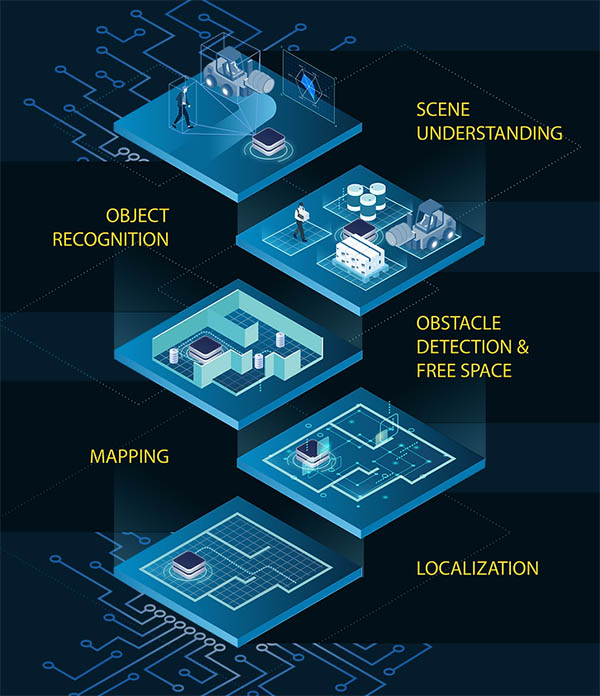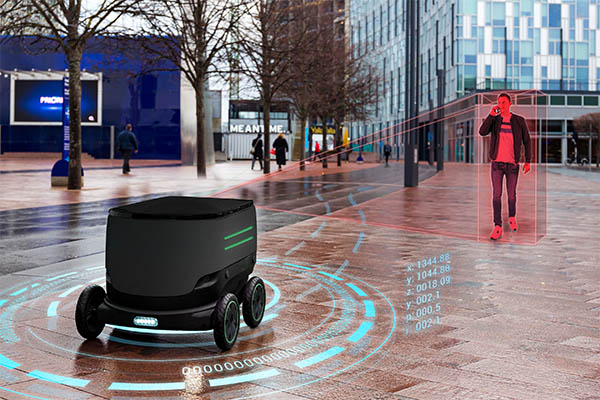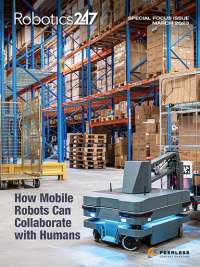RGo Robotics Inc., which is developing artificial intelligence-based 3D perception for mobile robots, today exited “stealth mode” with $20 million in funding. The startup said it plans to use the investment to expand its research and development and commercial teams to bring its Perception Engine to market.
Founded in 2018, RGo has offices in Caesarea, Israel, and Cambridge, Mass. The company claimed that its patent-pending AI and computer vision technology gives autonomous mobile robots (AMRs) “human-level perception.”
“Most mobile robots today are still blind and unable to navigate intelligently in dynamic and complex environments, and we see firsthand how hard it is for machine and robot manufacturers to develop basic visual perception on their own,” said Amir Bousani, co-founder and CEO of RGo Robotics.
“Our technology changes this,” he said. “Leveraging the most advanced AI and vision technologies, Perception Engine allows mobile machines to see and understand the world around them so they can move autonomously, safely, and intelligently in any environment. We call this 'intelligent autonomy.'”
Perception Engine designed for easy integration
RGo Robotics also announced the immediate availability of Perception Engine, which includes software that runs on low-cost, low-power hardware. With its software development kit (SDK), partners can easily integrate Perception Engine into their robots, said the company.
“RGo’s technology is leveraging computer vision and AI to extract the visual perception information needed for a machine to move safely in real-world environments,” Bousani told Robotics 24/7. “All the real-time information is extracted on the edge, on our reference hardware compute platform. Our team has vast experience in optimizing complex algorithms to run efficiently on affordable compute platforms.”
How did RGo keep both processing overhead and costs down?
“Efficient system and algorithm design is certainly among our team’s main areas of expertise,” replied Bousani. “We bring vast experience in designing mass-market, cost-efficient, camera-based products. We solve complex vision problems with robust algorithms that are very accurate, and automatically adapt per the availability of system resources and platform needs. This allows us to operate efficiently at varied speeds, and within different environmental dynamics, while using low-cost hardware.”

“We are well aware of the cost limitations for different robotic applications, so we designed our solution to provide the highest levels of performance to the most demanding applications, and to provide a cost-efficient solution to the most price-sensitive applications,” he added. “For most of our current customers, we use a single camera and an ARM-level compute platform.”
In addition to the perception data that its system generates on the edge, RGo can connect to a network and share information with other entities of a robot fleet, said Bousani. “One example is map sharing – one robot generates the map and can share it with every other machine that operates in the same environment,” he noted.
RGo Robotics offers value in API, robustness
Perception Engine learns its environment and provides the layers of information a robot needs to move naturally, said RGo Robotics. The product provides perception data over its application programming interface (API). This data is then consumed by the robot control system, which is responsible for path planning and autonomous behaviors, said the company.
“The Perception Engine API provides all the information a machine needs to move safely, even in complex and dynamic environments,” Bousani explained. “We run all the complex algorithms, and the API has the information in a simple and intuitive way.”
“On top of that, our biggest value is in the robustness of the solution, even in the most dynamic and unstructured environments,” he said. “Perception Engine was tested for many miles of travel, weeks of operation, and endless environmental challenges to prove its ability to maintain centimeters level of accuracy and uncompromising performance.”

RGo also tuned its perception stack to dynamically adapt to both indoor and outdoor operations. “This way, a platform based on the Perception Engine can operate either indoor or outdoor or move between them,” said Bousani. “This is a huge advantage of a vision-based system compared to most existing technologies.”
Early customers sign up
RGo said it has conducted extensive field trials and and already closed multiple customer deals.
“Our first customer engagements are on different types of mobile machines, including outdoor machinery, industrial automation, logistics, forklifts, service robots, and more,” said Bousani. “Some were for robotic applications, and some for man-driven machines, with the first level of autonomy.
“So far, we have secured several customers and closed over $10 million in customer deals,” Bousani said. “The design wins are with global, market-leading robot OEMs across multiple vertical markets.”
RGo has also given some thought to safety and cybersecurity. “The control interface is directly connected to the robot application processor to prevent cyber threats,” Bousani said. “The cloud interface is connected through the robot communication interface and protected by the same level of protection the machine supports. We also have low-level hardware settings to block unneeded data and control at the Perception Engine interface.”
Backers expect faster time to market
MoreTech Ventures led RGo Robotics' latest funding, which brings its total to more than $20 million, including its Series A in January 2022. Other backers include Converge, StageOne, and an undisclosed “global robotics leader.”
“MoreTech Ventures sees tremendous growth potential for the mobile robotics industry, and RGo’s technology is the key to unlock that potential,” stated Zack Keinan, general partner at MoreTech Ventures. “The applications for Perception Engine are nearly endless, from AGVs [automated guided vehicles and] AMRs in logistics and manufacturing to last-mile delivery and service robots, agriculture, and consumer applications.”
“RGo’s early traction with global market leaders is a testament to the technology and leadership team,” said Tal Slobodkin, managing partner at StageOne. RGo's leadership team has experience from Intel RealSense, iRobot, Google, Samsung, and others.
“As the use of robotics continues to exponentially grow across industries, RGo’s solution is a game-changer,” said Nilanjana Bhowmik, co-founder and general partner at Converge. “Manufacturers will be able to offer more intelligent mobile robots and accelerate time to market without having to focus their R&D teams on this extremely complex technology area.”
Looking ahead, Bousani said, “We are always working on the next levels of perception capabilities, including scene understanding, situational perception, object classification, movement prediction, and more.”
About the Author
Follow Robotics 24/7 on Linkedin
Article topics
Email Sign Up



















